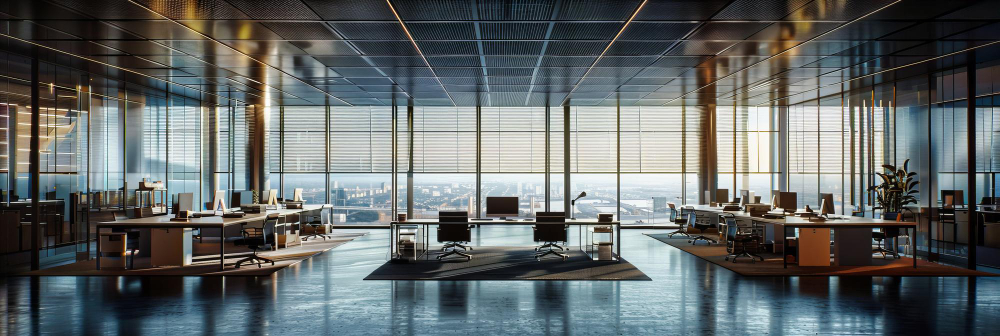A clean, organized, and clutter-free office isn’t just aesthetically pleasing; it’s crucial for creating an environment that fosters productivity, mental clarity, and even collaboration. Clutter can accumulate over time, leading to distractions and reduced efficiency. In this guide, we’ll explore how to design a clutter-free workspace and provide practical tips for setting up and maintaining an organized office that encourages focus and productivity.
The Impact of a Clutter-Free Workspace on Productivity
Clutter impacts productivity and stress levels. A study from Princeton University found that visual clutter competes for attention and ultimately makes it harder to focus on tasks at hand. Another study from the Journal of Environmental Psychology found that people working in organized spaces are more likely to make healthier decisions, both professionally and personally, and experience lower stress.
An organized workspace enhances mental clarity, boosts morale, and even encourages creativity. When employees feel calm and focused, they are better able to handle tasks efficiently, communicate effectively, and enjoy higher job satisfaction.
Identifying the Root Causes of Clutter in the Workplace
Before implementing organizational techniques, it’s helpful to understand where clutter originates. Common sources include:
- Paper Documents: Despite digital advancements, offices still rely on physical documents. When left unchecked, paper accumulates rapidly.
- Office Supplies: Excessive or poorly organized supplies can cause unnecessary clutter.
- Digital Clutter: Computer desktops and digital files can also contribute to a cluttered mind.
- Personal Items: Mugs, bags, and other personal belongings can lead to desk clutter when not properly managed.
Recognizing the root causes of clutter can help in devising a strategy to keep it under control, ensuring it doesn’t become a recurring issue.
Decluttering Essentials: Starting Fresh
To create a truly clutter-free workspace, begin with a clean slate by following these steps:

Clear Out the Space
- Remove Everything: Start by emptying drawers, shelves, and desks to assess what items are truly necessary. This allows you to reset your workspace and only add back essential items.
- Categorize Items: Organize items into categories like daily use, occasional use, and seldom-used or unnecessary items. This helps you determine which items need prime placement and which can be stored.
- Purge Unnecessary Items: Discard, recycle, or donate items you no longer need, such as expired stationery, outdated files, or broken equipment. This clears out immediate space and establishes a fresh base.
Create Zones for Efficiency
Assign specific zones for different activities or items. Designate one area for work tasks, one for storage, and another for personal items. This helps prevent overlap and keeps everything organized.
Set Up Basic Organizational Tools
Basic organizational tools like file cabinets, desk trays, and pen holders can make a big difference in keeping items off your desk. These small changes add up and create an environment where items are easy to access and store.
Sustaining a Clutter-Free Environment: Establishing Systems
Once you’ve set up your space, it’s crucial to establish systems that maintain order over time. Here are effective strategies for sustaining an organized workspace.

Desk Organization
- Limit Desk Items: Keep only the essentials on your desk. A minimalist desk setup with only a computer, notebook, and a few pens can reduce visual clutter and promote focus.
- Use Drawer Organizers: Invest in drawer organizers to separate items like paper clips, sticky notes, and other small supplies.
- Digital Decluttering: Keep your computer desktop organized, and regularly clean out emails and digital files. Establish folders and clear out junk files frequently.
Paper Management
Despite the digital age, paperwork is still a common clutter culprit. Consider these paper management techniques:
- Adopt a “One-Touch” Rule: When you handle a document, make a decision about it—file it, act on it, or discard it. This prevents papers from accumulating.
- Digitize Where Possible: Use digital tools like scanners or document management software to store records electronically. This reduces paper clutter and makes retrieval easier.
- Establish a Filing System: Set up a filing cabinet with labeled folders for easy organization and retrieval. Create categories for different types of documents, like invoices, receipts, and reports.
Organizing Office Supplies
- Limit Supplies: Keep only the supplies you frequently use at your desk. Store backup supplies in a communal area where employees can access them as needed.
- Use Storage Containers: Clear, labeled storage containers make it easier to organize supplies, reducing clutter and simplifying restocking.
Personalized Systems for Individual Workspaces
Each employee has unique needs, and creating customized systems for individuals can improve productivity and comfort. Here are some suggestions for creating personalized workspaces:
- Desk Arrangement: Encourage employees to keep their most-used items within arm’s reach. This helps minimize unnecessary movement and keeps the workflow smooth.
- Personal Items: Allow space for a few personal items, as they can make a workspace feel welcoming. However, set guidelines to keep personal belongings from overtaking work areas.
When team members feel empowered to personalize their space while following organizational guidelines, they’re more likely to keep it tidy and functional.
Communal Spaces and Collaborative Areas: Maintaining Order
In addition to individual workstations, communal spaces like meeting rooms, break rooms, and shared work areas need attention to prevent clutter.
Meeting Rooms
- Designate Supplies for Each Room: Place markers, pens, and a set of essential meeting tools in each room so items don’t accumulate over time.
- Clear After Each Use: Set up a system where team members remove items they brought in after meetings, keeping the space tidy for the next user.
Break Rooms
- Designate Storage for Personal Items: Provide a dedicated space for employees’ personal items, such as lunch boxes, to prevent clutter from accumulating on tables and counters.
- Establish Cleaning Rotations: Encourage employees to participate in regular cleaning and organization tasks for communal spaces.
Incorporating Digital Tools for Organization and Efficiency
Digital tools can be a powerful ally in maintaining a clutter-free workspace. Here are some digital resources that can help manage files, communication, and schedules more effectively:
Document Management Systems : Use tools like Google Drive, Dropbox, or OneDrive to organize digital files. These systems offer easy storage, accessibility, and sharing options, minimizing the need for physical paperwork.
Task Management Software: Platforms like Trello, Asana, and Monday.com keep track of tasks and deadlines, making it easier to prioritize without relying on sticky notes or paper lists. They’re also great for team collaboration, ensuring everyone stays on track.
Communication Platforms: Slack, Microsoft Teams, or Zoom offer real-time communication options that reduce the need for paper notes or in-person meetings. These platforms streamline communication, making it easier to connect with colleagues and access information in one central location.

Setting Maintenance Routines to Sustain a Clutter-Free Office
A clutter-free office requires consistent upkeep. Establish daily, weekly, and monthly routines to keep the space organized.
- Daily Routines: Encourage employees to spend a few minutes at the end of each day tidying up their desks, filing documents, and putting supplies away.
- Weekly Routines: Implement a weekly clean-up session where employees declutter shared spaces and workstations.
- Monthly Deep Clean: Conduct a monthly deep clean, addressing areas that may have accumulated clutter over time.
Encouraging an Office Culture of Cleanliness and Organization
A clutter-free workspace can only be sustained with buy-in from the entire team. Here’s how to foster a culture that values organization:
- Lead by Example: Managers and team leaders should model organized behaviors. A clutter-free workspace by a leader sets a standard for others.
- Provide Resources: Ensure employees have the tools and storage options they need to stay organized. From storage bins to label makers, having supplies on hand is essential.
- Incentivize Clean Workspaces: Reward teams or individuals who maintain organized workstations and contribute to keeping communal areas tidy.
Reaping the Benefits of a Clutter-Free Office
A clutter-free office goes beyond aesthetics. The benefits include:
- Improved Focus and Productivity: A clean workspace minimizes distractions, allowing employees to focus on their tasks.
- Enhanced Collaboration: Organized spaces make it easier for teams to communicate and collaborate effectively.
- Positive Work Culture: A tidy workspace promotes a culture of discipline and respect, fostering a positive work environment.
By implementing these practices, organizations can enjoy the lasting benefits of a clutter-free workspace, resulting in improved employee satisfaction and overall productivity.
Conclusion
Creating a clutter-free office is about more than just keeping things clean; it’s about fostering an environment that allows employees to focus, collaborate, and thrive. From individual workstations to communal spaces, every area of the office plays a role in establishing a productive environment. With these tips and strategies, any organization can create a workspace that is not only efficient but also supportive of a positive work culture.
